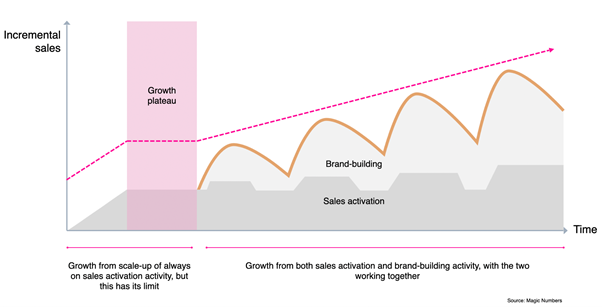A 5-point strategy to scaling up and how planning must change

Opinion
The market is changing, and so too are media behaviours. As strategists, it’s imperative we scale up ourselves and our approaches too.
For all the business challenges and setbacks of the last two years, we’ve continued to see ample growth in younger, often online-born brands.
While these span categories, what has enabled so many to flourish despite the pressures of lockdown is their digital-first offer.
In fact, as high street brands and larger, more complex businesses struggled to adapt during the pandemic, the conditions were often just right to enable these players to see rapid, early-doors growth.
However, the digital marketing tactics that facilitated the initial growth cycles will only take them so far, and continuing to scale becomes challenging without a shift in strategy.
In all but the rarest of cases, doing more of the same is simply not going to cut it. So how do brands break into the next stage of growth without falling into the many traps that await them in a complex, fragmented media market?
Beyond the plateau
The starting position and central driver for scale-up success is to introduce an approach that will work across the entire purchase funnel, pushing past the performance-centric growth plateau by embarking on a brand building and sales activation approach.

This places the audience, as ever, at the heart of the strategy – in the case of my own agency, this is based on the 3D planning approach I discussed in my previous column – with scaling up tactics driven by five key levers.
1. Investment planning
Businesses, rightfully, will feel nervous when they first peek over the plateau. They’re ambitious and they’ve secured past success, but scaling up costs money and that means taking a robust case to the boardroom.
It’s important, therefore, to understand how effective different channels are at delivering marketing KPIs, estimations of ROI, and how investment can be split across channels to maximise reach.
However, it remains an evolution, not a revolution. A balanced approach mitigates risk, maintains the online presence a brand has already worked so hard for, and allows an agency partner to test and learn as the growth strategy progresses.
What is particularly crucial here is that, thanks to Les Binet and Peter Field, any agency can use IPA best practice in terms of share of voice (SOV)/share of market (SOM) and the eternal debate between brand building and sales activation to guide investment planning.
But real boardroom confidence will come from bespoke scenario modelling and forecasting of revenue and brand goals. Every brand is different, after all, and every business goal is nuanced.
2. TV
Over the last few years we have seen a renaissance in new-to-TV advertisers flocking to the medium, with Nielsen Ad Intel reporting that, in 2021, 1,286 advertisers used TV for the first time, or returned after more than five years away.
This follows on from 1,243 new TV advertisers in 2020. And with TV still proving to be the most effective channel, and having the greatest incremental impact of any channel, you can see why.
But TV is changing and video diets are diversifying – TV isn’t just a box in your living room and YouTube isn’t a window on your desktop.
In May last year over 25 million people streamed YouTube on their TV screens in Great Britain.
Indeed, my kids spend more time watching Mr Beast’s YouTube videos on our TV more than anything else these days. It’s therefore best to think about AV, not TV.
Therefore, AV planning must move beyond silos and instead take a holistic approach based on reach-led planning that rigorously optimises across screens.
To help brands scale effectively, we also need to take a custom audience approach that ensures plans reflect diverse and complex media behaviours and is inclusive by design.
And we need to reconsider existing tools and instead apply cutting edge capabilities, new data (including the integration of first-party data where possible), tech and tools to fuel incrementality and move from outputs to outcomes-led approaches.
3. Digital
Generally speaking, many scale-up businesses have grown via growth hacking across the Google and Meta stacks, which means in-house digital performance teams are already in place and well versed in what works.
However, agencies can bring a unique perspective to these in-house teams, offering experience beyond the vertical or category a scale-up business finds itself in.
They can also show how to best manage digital activity in combination with brand building work, which is often new and uncharted territory.
Similarly, agencies can also work with scale-ups through proprietary technology, consultancy on best practice, diagnostics, integrations and training, and by offering commercial and technological improvements.
4. Creative
Of course creative accounts for so much in this business, but digging deeper, there is good evidence that fame through word-of-mouth and buzz marketing are common drivers of success for scale-ups as awareness is generally not strong enough in isolation.
I’ve touched before on the creative problems new-to-TV businesses often encounter when they first take the plunge. What helps, however, is ditching the tactics (and tone) that work online and learning to speak the language that befits the medium.
TV is very different to other channels, and the creative must be too. In simple terms, if you don’t want to screw it up, don’t put an online ad on TV.
Media and creative should also work more closely together to help online-born brands adapt to TV, ensuring that assets are created for the appropriate contexts and partnerships go beyond standard buys to integrate into programming and utilise IP.
5. Measurement
In pursuit of effectiveness, it is crucial to be able to learn and act quickly whilst keeping a long-term view of business growth.
In many cases scale-up businesses are used to the short term interaction-action measurement model, so ensuring confidence of adding brand building activity to the marketing mix is critical.
It’s also crucial to consider how everything affects business outcomes rather than siloing activity into ‘brand’ or ‘performance’ (as all media should perform).
Best practice is to combine a measurement framework with a learning agenda.
The framework should be constructed in tandem with the strategy and media plan and ladder-up to the business objectives.
The learning agenda should capture the questions that need to be answered and then built into the plan to provide practical outputs.
However, I don’t think it wise to implement lots of metrics instantly; instead they should be tailored over time. This is dependent on business maturity in the measurement space, but should ensure understanding across outputs (media delivery), outtakes (perceptions and customer attitudes), outcomes (consumer behaviour and marketing objectives) and – critically – the impact on business objectives.
Finally, considering the overall strategy – and incorporating all five levers discussed here – it’s essential strategists get every element right; there are many brands now in a position to scale-up, cementing the need for differentiation and tailored approaches.
The market is changing, and so too are media behaviours. That means, as strategists, it’s imperative we scale up ourselves and our approaches too.
Simon Carr is chief strategy officer at Hearts & Science
Strategy Leaders: The Media Leader‘s weekly bulletin with thought leadership, news and analysis dedicated to new ideas, challenges, and excellence in commercial media strategy.
Sign up for free to ensure you stay up to date every Tuesday.



